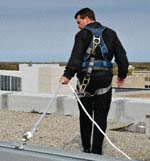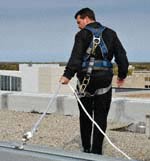
New ANSI Fall Protection Standards: What They Mean to You
Regulations clearly are not enough since, after more than 70 years of standards, rules, and regulations, workers still fall to their deaths in increasing numbers.
- By Thomas Kramer, Nolan Miller, P.E., C.S.P.
- Jan 01, 2010

Changes put forth in the ANSI Z359 standards released in 2007 and 2009 can significantly affect the use of PPE.
Learning how to minimize the risk of potentially dangerous or fatal fall hazards allows organizations to take a proactive approach to worker safety. In November 2007, the American National Standards Institute (ANSI) released a comprehensive family of standards, known as the Z359 standard or "Fall Protection Code," to help organizations learn how to reduce risk. Federal, petroleum, manufacturing, institutional, and other organizations are adopting all or parts of this standard to reduce the gaps in their fall protection programs. Because OSHA's regulations have been relatively unchanged since the early and mid-1990s, there is a demand for this information — especially information that is at the leading edge technically. To provide even more guidance, particularly related to active fall protection systems, ANSI published additional standards in November 2009.
The publication of the ANSI Z359 standards provides more guidance than any single resource for developing and implementing a fall protection program. This information is critical because falls affect the quality of life for the worker and the bottom line for the company. The goal is to reduce risk and improve safety for work at heights.
Common, and potentially fatal, misconceptions about fall protection are that it is harder to work, it slows down work activity, and it is too difficult to implement. Regulations clearly are not enough since, after more than 70 years of standards, rules, and regulations, workers are still falling to their deaths in increasing numbers. According to the Bureau of Labor Statistics, fall fatalities increased 28 percent in the same time period (1995-2007) that overall workplace fatalities decreased 12 percent.
Background
The ANSI Z359 standards released in 2007 not only provide an update to the previous Z359.1 standard on personal fall arrest systems, but the standards also give more detailed guidance on comprehensive managed fall protection programs (.2), positioning and travel restraint systems (.3), and rescue (.4). Some of the key changes included in the standards became immediately visible and effective due to changes in equipment. For example, the required snaphook gate strength changed significantly from the previous standard of 220 pounds (front load) and 350 pounds (side load) to the 2007 standard of 3,600 pounds for both front and side loads. It is important to note that snap hooks designed to the Z359.1-1992 (R1999) standard still meet the OSHA regulation for a locking snaphook.
Many times, standards or rules are changed to correct unsafe equipment. This was not the case with the 2007 standards. The changes serve to enhance safety — to make workers at heights even more safe and at less risk for injury.
Managed Fall Protection Programs
Although it is beneficial to abate a fall hazard successfully, without a true fall protection program, you may be spending resources on solutions that do little to reduce your overall risk. The elements of a fall protection program, as outlined in the ANSI Z359.2-2007 standard, are foundational for creating a program that reduces risk and improves safety for work at heights. When one or more of the elements is missing, a program can become stalled or be deemed ineffective.
The program elements outlined in the ANSI Z359.2-2007 are:
- Policies, duties, and training
- Fall protection procedures
- Eliminating and controlling fall hazards
- Rescue procedures
- Incident investigations
- Evaluating program effectiveness
With thorough information on each of these distinct elements, the ANSI Z359.2 standard can help you establish a managed fall protection program or improve on one specific aspect. For example, in the procedures section, the standard gives detailed information on fall hazard surveys, which represent a critical step toward identifying and prioritizing fall hazards. Once you understand the magnitude of fall hazards and potential risks associated with them, an initial validated budget can be created. Then, a phased implementation plan can be developed based on priorities and budget.
New Standards
To provide further guidance, the ANSI Z359 family of standards added new sections focusing on active fall protection systems in November 2009.
ANSI Z359.6 — Specifications and Design Requirements for Active Fall Protection Systems
ANSI Z359.12 — Connecting Components for Personal Fall Arrest Systems
ANSI Z359.13 — Personal Energy Absorbers and Energy Absorbing Lanyards
The goal of the new ANSI Z359.6-2009 standard is to provide uniform guidelines for engineers designing active fall protection systems, including travel restraint and vertical and horizontal fall arrest systems. Before the release of the standard, the only guidance on designing fall protection systems came from OSHA, stating that anchorages and horizontal lifelines must be "designed, installed and used under the supervision of a qualified person." But what does that mean? If you asked 10 people, you probably would get 10 different answers. One area that continues to be debated is what criteria should be used to designate someone as a qualified person. This was addressed in the Z359.2-2007 standard.
Although much of the practical application of the .6 standard will be executed by engineers, it is also critical for safety managers to understand the framework of the standard. Having an awareness of the standard will allow safety professionals to be better consumers, ensuring they receive a properly designed system. The key to remember is that designing a fall protection system is more than identifying an anchorage of adequate strength. In addition to addressing the strength design, this standard provides the other requirements for the system, such as procedures and training.
Key topics from the ANSI Z359.6 standard that should be of interest to anyone working with active fall protection systems are ballasted style anchors, multiple worker falls, and clearances. For example, what do you do if you are on a roof and there is nothing that can serve as an anchor? Ballasted style anchors are manufactured products or systems that people can assemble and use. The ANSI Z359.6 standard provides guidelines to consider when evaluating their suitability as a means of fall protection.
The .12 standard addresses connectors for personal fall arrest systems. The standard provides detailed information on D rings, snaphooks, buckles, and adjusters. These connectors are integral components, which means they are always part of another component, such as a lanyard, harness, vertical lifeline, etc. Carabiners are also addressed, although this component may or may not be integral to another component. One important reminder is that this standard does not address anchorage connectors. Anchorage connectors will be addressed by a separate standard.
The .13 standard provides key information on lanyards and energy absorbers for personal fall arrest systems. Key topics of the standard include changes to the components' test weight, lanyards rated for a 12-foot free fall, and increased deceleration distance. The standard also provides valuable information on twin-leg or Y lanyards and guidance for determining maximum arresting force.
The changes presented in the .12 and .13 standards present challenges for a variety of reasons. First, you may purchase a self-retracting device that is designed to the ANSI Z359.1-2007 standard. The ANSI Z359.1-2007 standard contains requirements for both self-retracting lanyards and snaphooks. However, there is a more recent standard for snaphooks: ANSI Z359.12- 2009. This scenario can be expanded to diff erent components of a fall protection system, such as anchorage connectors and harnesses. Safety professionals will need to stay aware of these new standards as they become effective.
Moving Forward
The ANSI Z359 committee is moving forward on additional standards that will provide guidance for fall protection programs and systems. Future standard topics include:
- System requirements
- Rope access systems
- Descending devices
- Full-body harnesses
- Self-retracting devices
- Vertical lifelines
- Fall arresters
- Horizontal lifelines
- Anchorage connectors
Each of the new standards released provides additional guidance for maintaining an effective fall protection program. The ultimate goal, of course, is to increase safety and reduce risk for work at heights. As more forward-thinking companies adopt the guidelines presented in the new and upcoming ANSI Z359 standards, the closer we collectively step toward reversing the trend of increasing fall fatalities — and that's really what it's all about.
This article originally appeared in the January 2010 issue of Occupational Health & Safety.